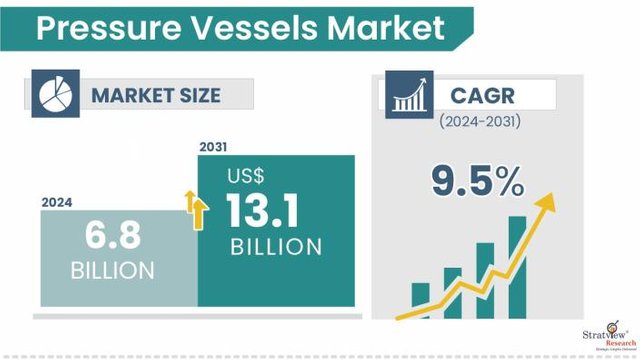Pressure Vessels Market: Key to Safe and Efficient Industrial Operations
Pressure vessels are a critical component in numerous industries where pressurized gases or liquids need to be stored or transported safely. These vessels are designed to withstand high internal pressures, ensuring that chemical reactors, storage tanks, and heat exchangers operate efficiently while maintaining safety standards. From oil and gas to chemical processing and energy production, pressure vessels are indispensable in industrial operations.
Stratview Research forecasts that the pressure vessels market will grow at a CAGR of 9.5% from 2024 to 2031, reaching USD 13.1 billion by 2031. This growth is driven by increasing industrial activities, advancements in materials, and the rising demand for energy-efficient solutions.
Download the sample report here, to uncover in-depth insights.
https://stratviewresearch.com/Request-Sample/438/Pressure-Vessel-Market.html#form
What Are Pressure Vessels?
Pressure vessels are containers designed to hold gases or liquids at high pressure and are built to withstand the stress caused by internal pressure. These vessels are typically made of steel, composite materials, or specialized alloys to ensure they can handle extreme conditions. Pressure vessels are used in a variety of applications, such as compressed gas storage, chemical reactors, and heating systems.
Applications of Pressure Vessels
1. Oil & Gas Industry: Pressure vessels are used in the oil and gas industry for the storage and transportation of liquefied petroleum gases (LPG), natural gas, and crude oil. They are also used in refineries to hold chemicals under pressure during refining processes.
2. Chemical and Pharmaceutical Industries: In the chemical industry, pressure vessels are essential for chemical reactions and storage of reactive gases and liquids. The pharmaceutical sector uses pressure vessels for sterilization and reactor systems in drug manufacturing.
3. Power Generation: Power plants, particularly nuclear and thermal power plants, use pressure vessels for boiler systems, steam turbines, and reactors. These systems operate under high pressure and temperature to generate electricity.
Market Drivers for Pressure Vessels
1. Industrialization and Infrastructure Growth: The rising demand for pressure vessels is closely tied to the expansion of industrial infrastructure, especially in developing regions. Growing industries such as chemical manufacturing, energy, and food processing are driving the demand for pressure vessels.
2. Technological Advancements in Material Science: The development of high-strength composite materials and corrosion-resistant alloys is enabling manufacturers to design more durable and lightweight pressure vessels. These advancements allow for higher performance under extreme pressure conditions.
Challenges in the Pressure Vessels Market
1. Cost of Manufacturing and Maintenance: The initial cost of manufacturing high-performance pressure vessels, especially those made from specialized alloys, can be significant. Additionally, regular maintenance and inspection are required to ensure safety and compliance with regulatory standards.
2. Regulatory Compliance: Pressure vessels are subject to strict safety regulations, and ensuring compliance with industry standards such as ASME (American Society of Mechanical Engineers) codes can increase manufacturing complexity and costs.
Conclusion
The Pressure Vessels Market is expanding due to increased industrial activities, the demand for energy-efficient solutions, and technological advancements in materials. As industries continue to grow, pressure vessels will remain critical to ensuring safety, efficiency, and reliability in high-pressure environments.
